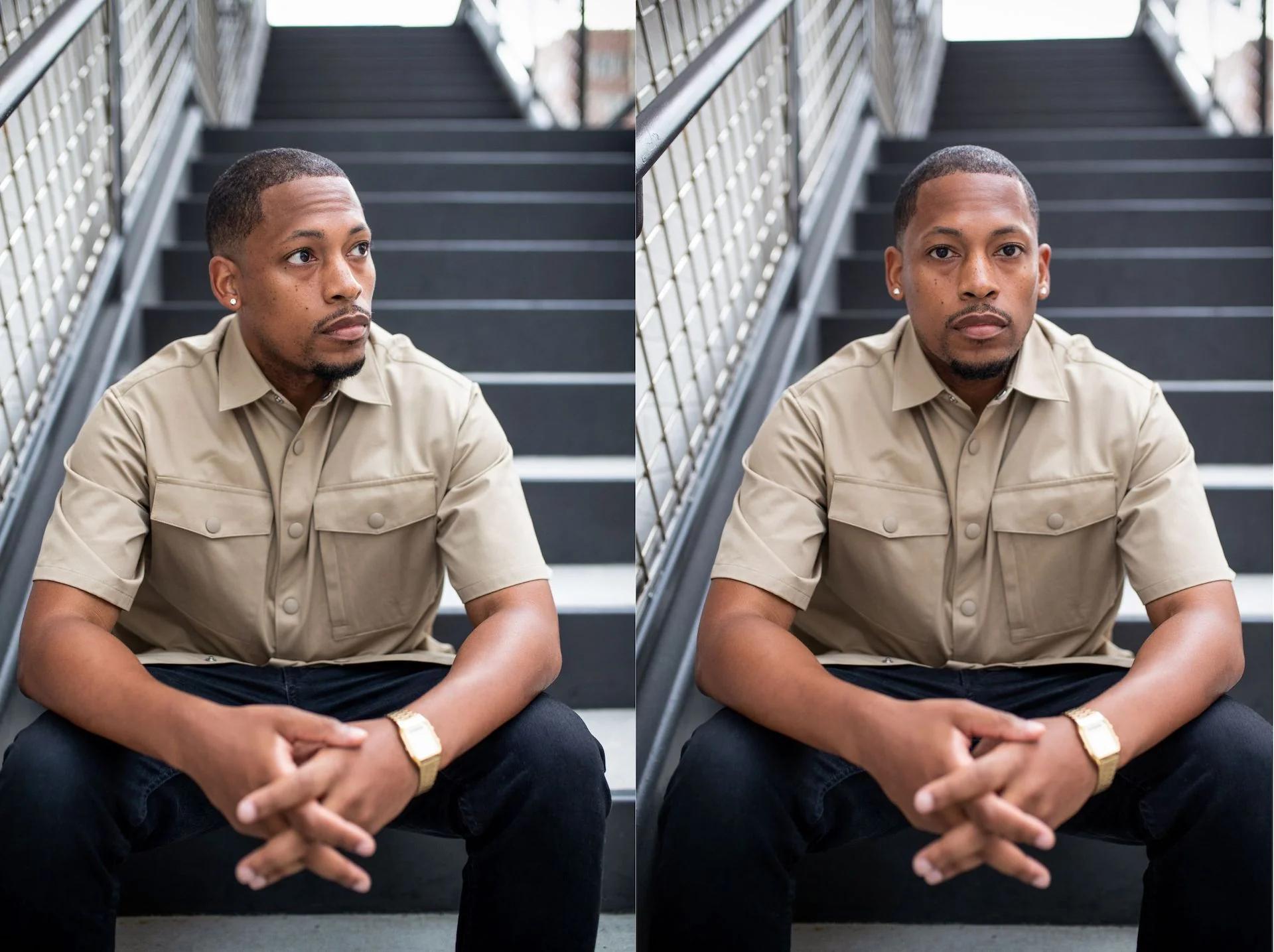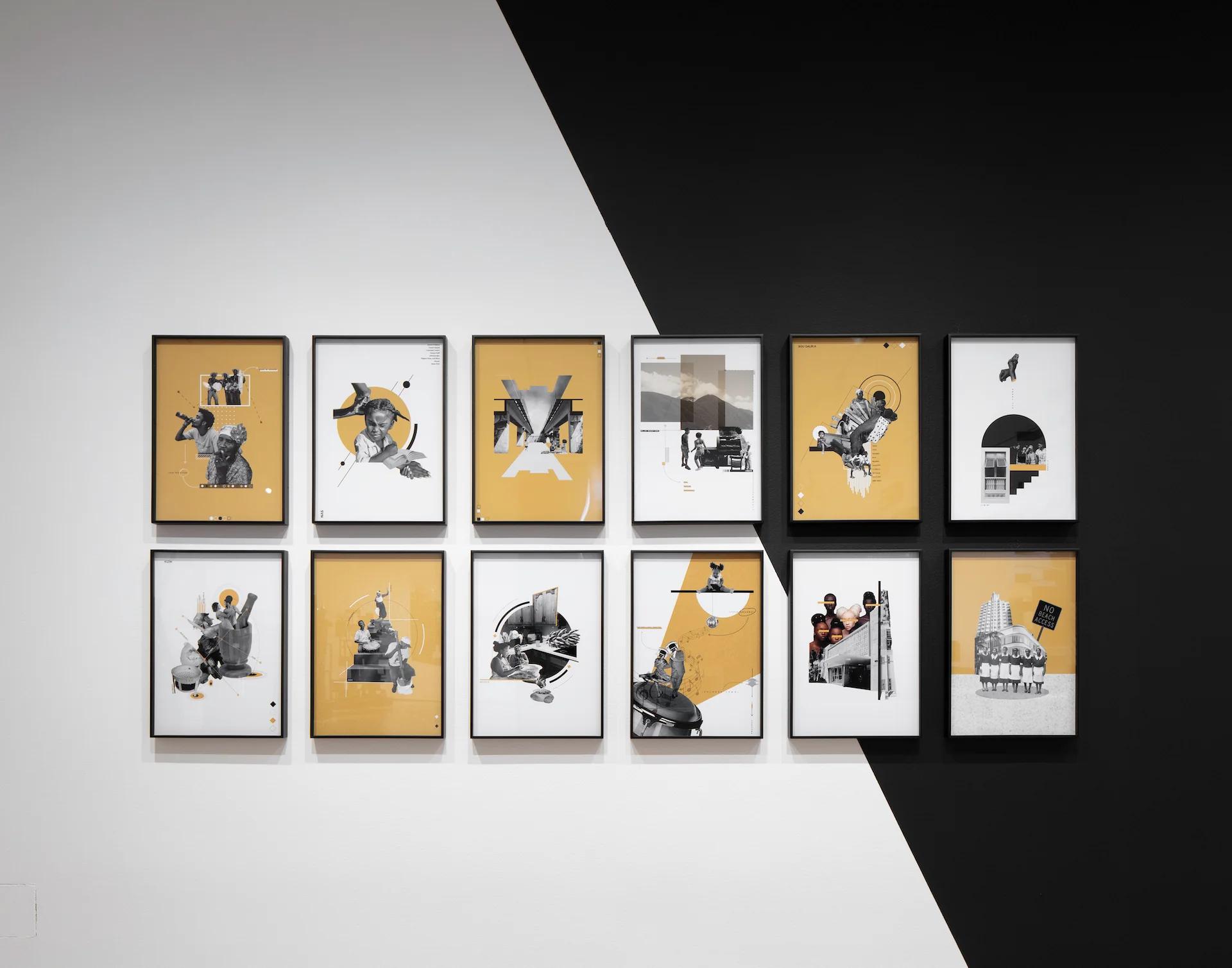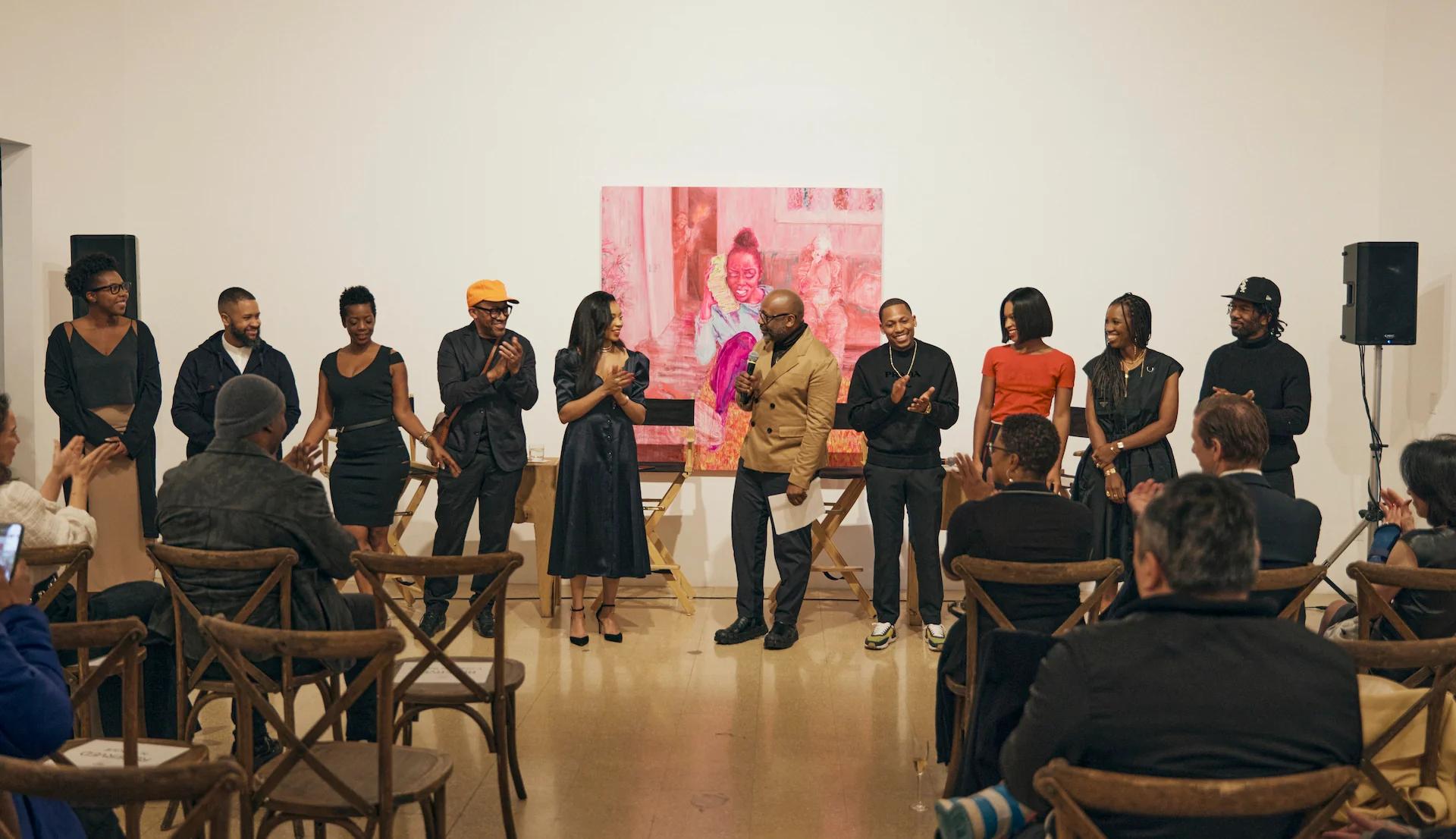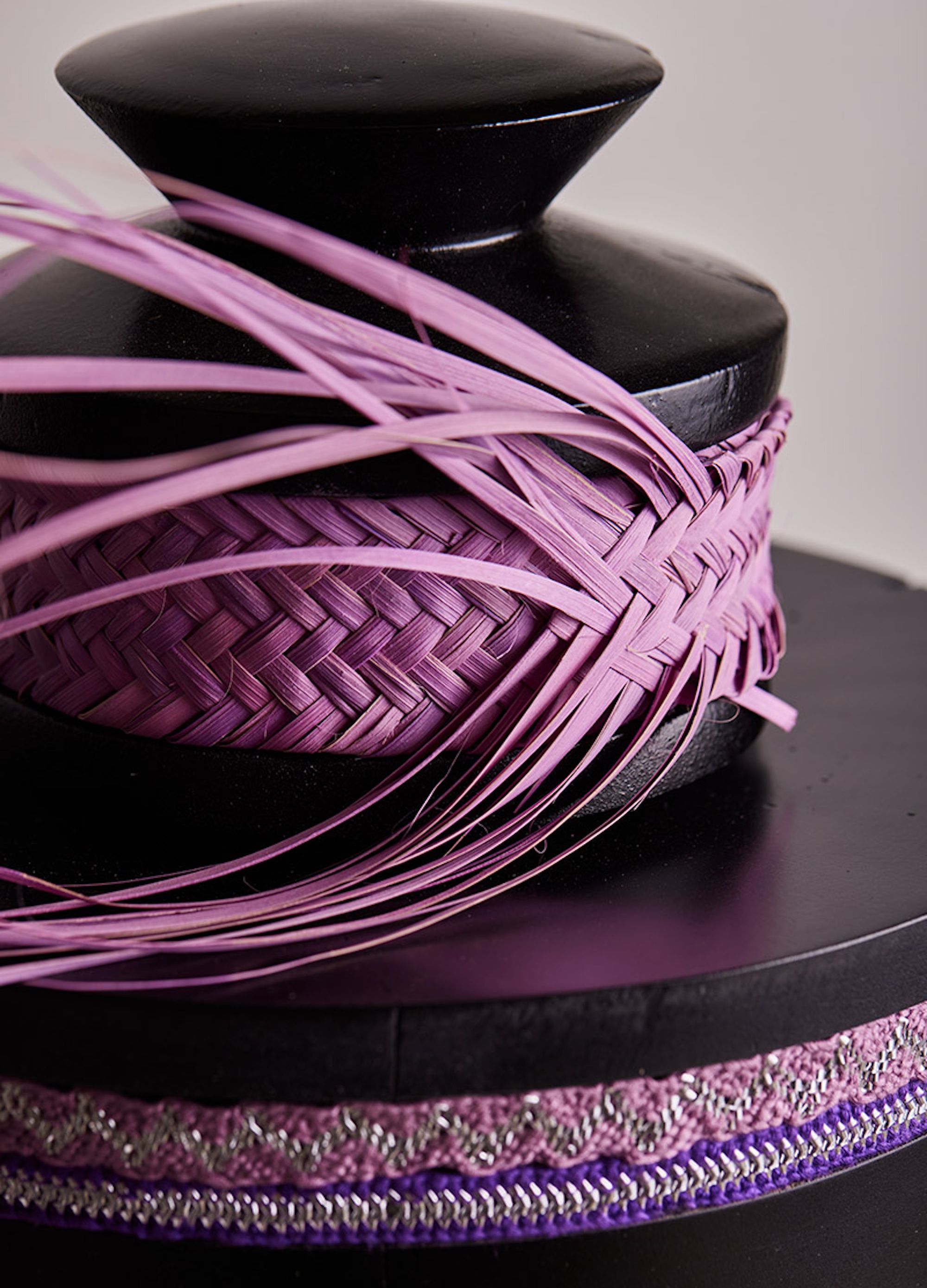IN COLLABORATION DECEMBER 21 2022
by Anna Carnick
Germane Barnes’ winning installation for the Miami Design District celebrates the communities who shape the city’s vibrant culture

MIAMI-BASED ARCHITECT-DESIGNER GERMANE BARNE
Portrait by Blair Reid-Avizionary Inc.
In 2013, fresh out of grad school and just 27 years old, Chicago-born architect-designer Germane Barnes moved sight-unseen to Opa-locka, Florida to help launch a project that would, in many ways, foreshadow the award-winning practice he would go on to build. Dubbed “Made in Opa-locka,” the innovative urban revitalization initiative offered architecture and design services aimed at boosting small businesses and civic spaces in the historically underserved city just 20 minutes north of Miami. “The goal was to lead a community design initiative by actually living in the community,” says Barnes. Getting to know the people whom the project was intended to serve—those who knew the area and its needs best—was key. “How can I truly help a neighborhood if I don’t spend significant time developing relationships with and within it?”
Collaborating hand in hand with residents and the Opa-locka Community Development Corporation, “Made in Opa-locka” helped drive a major cultural transformation in the area in just a few short years, creating a thriving local arts space and urban farm, and bringing to life a previously downtrodden park. By involving local stakeholders, the project actively pushed back against the currents of gentrification that shape so much of Miami-Dade County’s development. “We didn’t do a single thing without community buy-in,” Barnes recalls. “The neighborhood kids designed the new Magnolia North Park themselves.”

URBAN FARM IN OPA-LOCKA
Photo courtesy of Studio Barnes
A decade later, that human-centric approach continues to fuel Studio Barnes, his independent Wynwood-based studio, attracting national and international acclaim for multidisciplinary projects that delve deep into the ways that our built environments entwine with identity, both implicitly and explicitly, historically and today. Working across scales, from urban interventions to furniture design, Barnes shines a light on how spaces and objects have the power to reflect, amplify, or diminish the lived experiences of communities, especially BIPOC communities, who have traditionally been excluded from design processes and planning.

GERMANE BARNES
Courtesy of Miami Design District
“I try the best that I can to center the people who are critical to development of cultural capital but who are often ignored and neglected,” Barnes says of his practice’s guiding principles. “I also find powerful inspiration in designing things that make people happy and allow them to feel a personal connection. Perhaps the prevailing aspect of my practice, however, is my own identity as a Black American; this frame is always present in my work. My family is at least six generations back into the forming of this country. I enjoy using design to tell the stories of my ancestors. It is my way of honoring my family.” Further encapsulating his credo, he adds, “If my grandmother doesn’t understand my proposal, I’ve done something wrong. I want people to see themselves in the work. It should be accessible to everyone.”
It’s an approach that resonates with grandmothers and cultural gatekeepers alike. In the past two years alone, Studio Barnes has collected more than a few high-profile accolades. They have been included in the landmark MoMA exhibition Reconstructions: Architecture and Blackness in America (with a project that reframed sites of historic injustice in Miami as places of opportunity); awarded a grant from Theaster Gates and Prada’s new Dorchester Industries Experimental Design Lab (a high-profile creative incubator for exceptional BIPOC creatives); and earned both a prestigious Rome Prize and Creative Capital Award for the studio’s recent speculative project Restructuring Blackness, which examines the woefully ignored African diasporic contributions to the history of classical architecture—and the possibilities that emerge from incorporating Blackness in the corrective reformulation of the architectural canon. Always community minded, Barnes is quick to point out that “these honors and awards are not my own but my team’s; we design together and shoot ideas back and forth.”

WORKS FROM BARNES’ A SPECTRUM OF BLACKNESS, PART OF MOMA’S LAUDED 2021 RECONSTRUCTIONS EXHIBITION
Photo by Naho Kubota
As for the roots of his clarity of purpose, Barnes says that he’s wanted to be an architect since he was a young boy and credits his parents for supporting his dream. “They used their financial privilege to give me every opportunity to succeed,” he explains. “Not everyone has that support system, and I was able to fail repeatedly knowing that my family would be there to assist me.”
Barnes points to a pivotal experience in South Africa following his undergrad studies as another defining moment in his career trajectory. Having trouble finding work locally, Barnes’ professors suggested he look abroad. He ended up in Cape Town, interning for an architecture firm that specialized in high-end residential projects and pro bono work in impoverished areas. “I saw a four-year-old lead an even smaller child to a shipping container that served as the only market in the area. It was an illuminating experience.” Reflecting on his time in Cape Town now, he says, “I learned the power of design and how I could use my talents to improve the lives of others, which put me onto a specific trajectory of collective and community design that I would not have pursued otherwise.”
Barnes’ path also includes encounters with an incredible list of people he playfully categorizes as “accidental” mentors—such as Dr. Jafari Allen, anthropologist and expert in Black Queer Studies; acclaimed artists Amanda Williams and Theaster Gates; Justin Garrette Moore, Program Director at the Mellon Foundation; and Jennifer Bonner, architect, professor, and dear friend, who originally spearheaded Made in Opa-locka along with her partner, Christian Stayner. “They don’t realize it when it’s happening, but before they know it, I’ve called them repeatedly for advice,” he says.

DORCHESTER INDUSTRIES EXPERIMENTAL DESIGN LAB’S INAUGURAL AWARDEES WITH THEASTER GATES (CENTER)
Photo by Chris Strong; Courtesy of Rebuild Foundation
Barnes’ latest project, Rock | Roll—winner of the 2022 Miami Design District Annual Neighborhood Commission—continues his focus on identity by celebrating the people who’ve helped make Miami what it is today. The neighborhood-wide, multi-scale installation is “a love letter to the city,” that draws on the visual language of Miami Carnival to pay tribute to the BIPOC communities who’ve substantially contributed to Miami’s polyethnic culture, from the city’s earliest foundations to today.

ROCK | ROLL BY GERMANE BARNES, WINNER OF THE 2022 MIAMI DESIGN DISTRICT ANNUAL NEIGHORHOOD COMMISSION, CURATED BY ANAVA PROJECTS
Rock | Roll features a series of whimsical, larger-than-life seating capsules (or “Rockers”) that rock back-and-forth when activated by users. The seating is covered in colorful foam surfaces reminiscent of both Carnival’s hallmark feathered regalia and the area’s water-friendly lifestyle. With a nod to steel drums and the infectious joy of Soka music, Barnes has also designed brightly hued wind chimes, hundreds of which are currently hung like music-making ornaments in the neighborhood’s lush native trees and planted palms. Lastly, The Roll, an architectural-scale, floating dome recalls a giant disco ball in both form and function. Suspended far overhead and animated by light and sound, the faceted half disco ball structure serves as a programmatic marker to an outdoor gathering space dedicated to sharing and enjoying community-driven storytelling and programming—developed with University of Miami’s Center for Global Black Studies, among other local collaborators. “Collectively,” Barnes says, “this project brings Carnival into the heart of the Design District for everyone to enjoy.”

THE ROLL, A FACETED, ARCHITECTURAL-SCALE FLOATING DOME, RECALLS A GIANT DISCO BALL IN BOTH FORM AND FUNCTION, SERVING AS A GATHERING SPACE
Photos by Kris Tamburello; Courtesy of Miami Design District
Beyond Carnival, Barnes sees the project as an opportunity to celebrate Miami and the “joyful spirit” of its Black communities. “This city would not be what it is today without significant contributions from people who, on the one hand, look like me, and on the other reflect deep ties to places beyond Miami, especially the Caribbean and Latin America. The moral to the story is that there is space for everyone here,” he says. “Miami has treated me well beyond what I deserve. It has allowed me to use the city as a test bed for new ideas and processes. Rarely does a young designer get to use an entire city as a research project. And I love that.”
Barnes himself has vivid recollections of his own first visit to Miami Carnival. “Being from Chicago I am well experienced in large festivals,” he says. “But nothing compared to the intensity and vibrancy of Carnival. The colors, the music, the people were something I had never seen before. It was truly inspiring to see so many diverse faces enjoying themselves. This showed me how important it is to understand the various strands of community that populate the city.”

GERMANE BARNES/ ROCK | ROLL
Photos by Kris Tamburello, courtesy of Miami Design District
Those strands are integral to his Design District project. “Rock | Roll was inspired by the marginalized communities that built the city of Miami—both literally and figuratively. Many people who visit Miami don’t know that Bahamians helped create this tourist destination. Many people who live in Dade County don’t know that Miami is only recognized as an incorporated city because of Black male voters who tipped the scales over a hundred years ago. Given the history of Miami and of the Design District neighborhood, celebrating and uplifting the history of BIPOC communities was critical to the proposal,” says Barnes. “When I work on projects, I need to find a deep personal connection in order to do the best work, in my opinion. That is what makes Rock | Roll so important to my practice and research, because it combines many of the themes that I use in my work on a regular basis. It uses the city as a testing ground for speculation; it uses design to tell a compelling story; it celebrates local culture and influence; and it centers forgotten or suppressed legacies.”
For Barnes, looking forward is as important as looking back. Past, present, and future collide, as cultivating an inclusive playing field for the current and next generations of creatives is inextricably connected to calling out design’s historical inequities. The success of his work shows that there is not only space but a welcoming audience for design that amplifies a diversity of voices. Asked what advice he gives to other young designers and architects today, Barnes replies, “I never knew where architecture would take me, but I knew I loved designing things. Be bold and be brave. The practice you envision may have precedents or not, but it’s waiting on you to create it.”
Germane Barnes’ Rock | Roll is on view now through early 2023 throughout the Miami Design District. For more information on the installation and related community programming,visit miamidesigndistrict.net A special iteration of the project wasfeatured at the entrance of Design Miami/2022 for the duration of the fair as well.
This story first appeared in the Winter 2022 edition of Miami Design District Magazine. The text has been slightly edited.


